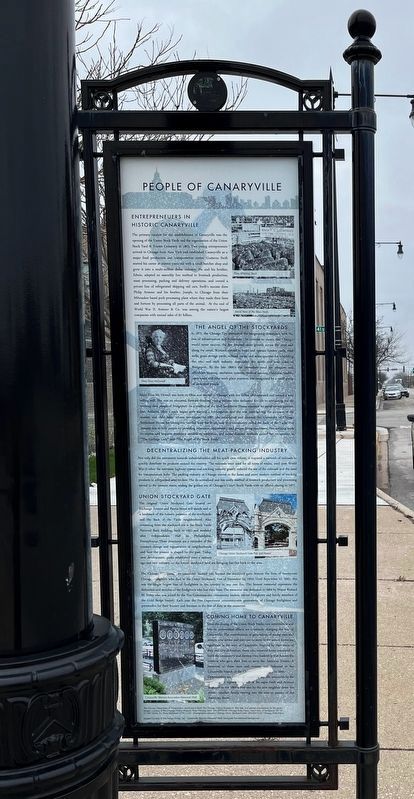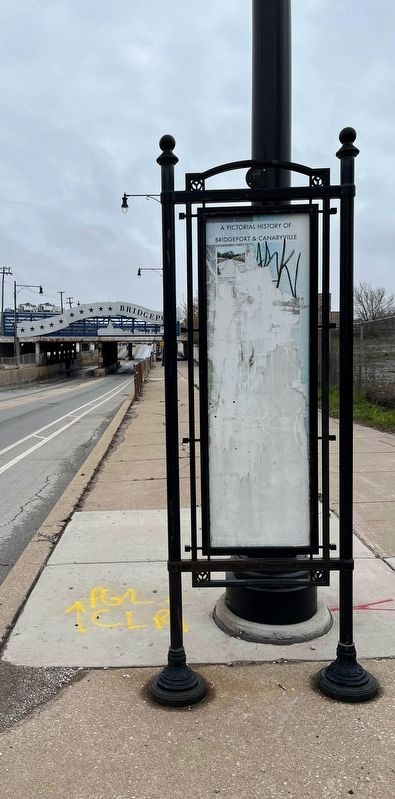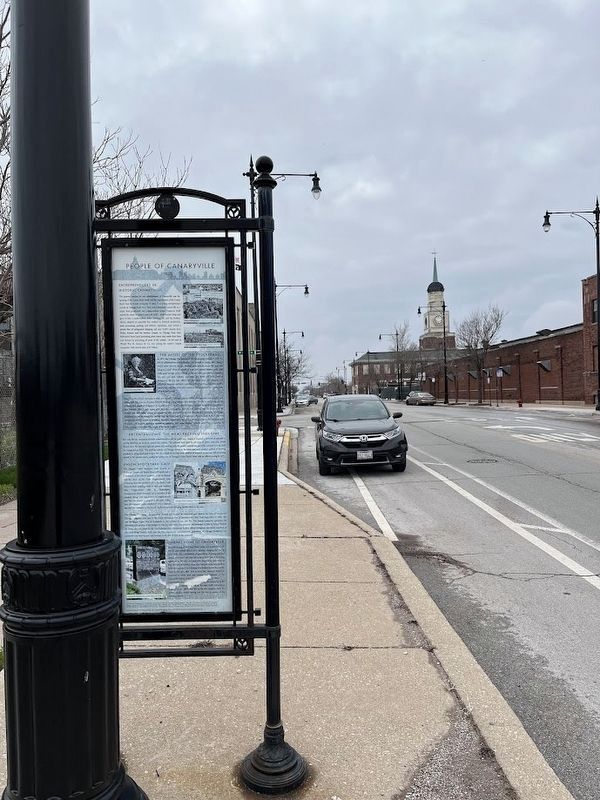Canaryville in Chicago in Cook County, Illinois — The American Midwest (Great Lakes)
People of Canaryville
The primary catalyst for the establishment of Canaryville was the opening of the Union Stock Yards and the organization of the Union Stock Yard & Transit Company in 1865. Two young entrepreneurs arrived in Chicago from New York and established Canaryville as a major food production and transportation center. Gustavus Swift started his career at sixteen years old with a small butcher shop and grew it into a multi-million dollar industry. He and his brother, Edwin, adapted an assembly line method to livestock production, meat processing, packing and delivery operations, and owned a private line of refrigerated shipping rail cars. Swift's success drew Philip Armour and his brother, Joseph, to Chicago from their Milwaukee based pork processing plant where they made their fame and fortune by processing all parts of the animal. At the end of World War II, Armour & Co. was among the nation's largest companies with annual sales of $1 billion.
The Angel of the Stockyards
In 1871, the Chicago Fire devastated the burgeoning downtown with the loss of infrastructure and businesses. In contrast to claims that Chicago would never recover, the fire spurred more growth across the river and along the canal. Workers arrived to build and operate lumber yards, steel mills, grain storage yards, railroad yards, and stone quarries for rebuilding the city, and such industry dominated the north and west sides of Bridgeport. By the late 1800's the immediate need for adequate and affordable housing, sanitation systems, medical services, childcare, healthy open space and safer work place practices was recognized by a small group of dedicated people.
Mary Eliza Mc Dowell was born in Ohio and moved to Chicago with her father who operated and owned a steel rolling mill. She was an educated, forward-thinking young woman who dedicated her life to advocating for the working class people of Bridgeport. As a resident of the Hull Settlement House operated by social service pioneer, Jane Addams, Mary's work began with starting a kindergarten and she was soon among the pioneers of the women and child labor reform movement. In 1901 she established and directed the University of Chicago Settlement House for immigrant families near the Stockyards in a community called the Back of the Yards. Her mission was to help people by providing education, opportunity, and proper living conditions. Her untiring work to expose and improve stockyard conditions, sanitation, and refuse disposal methods gained her recognition as "The Garbage Lady" and "The Angel of the Stock Yards".
Decentralizing the Meat-Packing Industry
Not only did the movement towards industrialization
call for quick civic reform, it required a network of railroads to quickly distribute its products around the country. The railroads were used for all types of trades, until post World War II when the interstate highway system and trucking industry greatly reduced the use of the railroads and the need for transportation hubs. The packing industry in Chicago moved to the faster and more modern method of trucking products in refrigerated semi trailers. The de-centralized and less costly method of livestock production and processing moved to the western states, ending the golden era of Chicago's Union Stock Yards with its official closing in 1971.
Union Stockyard Gate
The original Union Stockyard Gate located on Exchange Avenue and Peoria Street still stands and is a landmark of the historic presence of the stockyards and the Back of the Yards neighborhood. Also remaining from the stockyard era is the Stock Yards National Bank building, built in 1925 and modeled after Independence Hall in Philadelphia, Pennsylvania. These structures are a reminder of the constant change and regeneration of neighborhoods and how the present is shaped by the past. Today, new development, parks established over a century ago and new industry on the former stockyard land are bringing families back to the area.
The Chicago Stockyards Fire Memorial, located just beyond
the stockyard gate, honors the lives of twenty-one Chicago firefighters who died in the Union Stockyards Fire of December 22, 1910. Until September 11, 2001, this was the single largest loss of firefighters in the country in any one fire. The bronze memorial represents the dedication and sacrifice of the firefighters who lost their lives. The memorial was dedicated in 2004 by Mayor Richard M. Daley who was joined by the Fire Commissioner, community leaders, retired firefighters and family members of the Gold Badge Society. Each year the Fire Department commemorates generations of Chicago firefighters and paramedics for their bravery and heroism in the line of duty at the memorial.
Coming Home to Canaryville
Since the closing of the Union Stock Yards, new construction and historic preservation efforts are constantly changing the fate of Canaryville. The contributions of generations of young men and women who served and continue to serve in the armed forces are significant in the story of Canaryville. Inspired by their sense of duty and love of freedom, those who returned home continued to build the community and develop civic leadership that honors the veterans who gave their lives to serve the American Dream. A memorial to these men and women was dedicated at the Canaryville branch of the Chicago Public Library in 2005. Opportunities are numerous within Canaryville, noticeable by the new business reminiscent of the signs Swift and Armour displayed in the 1860's, and also by the new neighbor down the street — another family moving into the area in pursuit of the American dream.
Erected by Chicago Department of Transportation.
Topics. This historical marker is listed in these topic lists: Agriculture • Charity & Public Work • Industry & Commerce • Railroads & Streetcars. A significant historical year for this entry is 1865.
Location. 41° 49.238′ N, 87° 38.747′ W. Marker has been reported damaged. Marker is in Chicago, Illinois, in Cook County. It is in Canaryville. Marker is on South Halsted Street north of West 41st Street, on the right when traveling north. Touch for map. Marker is in this post office area: Chicago IL 60609, United States of America. Touch for directions.
Other nearby markers. At least 8 other markers are within walking distance of this location. Union Stock Yard Gate (approx. 0.2 miles away); Leslie F. Orear (approx. 0.2 miles away); The Fallen 21 (approx. 0.2 miles away); Union Stock Yard (approx. 0.2 miles away); Lt. Joseph T. (Jay) McKeon Jr. Park (approx. 0.6 miles away); Andrew "Rube" Foster (approx. ¾ mile away); Bridgeport and the Development of Chicago's Infrastructure (approx. 0.8 miles away); Carlton Fisk (approx. 0.9 miles away). Touch for a list and map of all markers in Chicago.
More about this marker. The south-facing side of the marker is almost completely missing, other than the title ("A Pictorial History of Bridgeport & Canaryville") and part of one photo. On a separate sign in an identical style, located about 7 blocks north of this location, the pictorial history included a map of the area and photos of nine area landmarks.
A similar style of historical marker can be found at Union Stock Yard Gate, about ½-mile southwest by car from here, in at least one marker about a mile north in Bridgeport, and also in series of markers found in the Loop on Dearborn and State streets.
Also see . . . Encyclopedia of Chicago: Canaryville.
Excerpt: "Canaryville's name may originally have derived from the legions of sparrows who populated the area at the end of the nineteenth century, feeding off stockyard refuse and grain from railroad cars, but the term was also applied to the neighborhood's rambunctious youth, its 'wild canaries.'"(Submitted on April 3, 2024, by Sean Flynn of Oak Park, Illinois.)
Credits. This page was last revised on April 7, 2024. It was originally submitted on April 3, 2024, by Sean Flynn of Oak Park, Illinois. This page has been viewed 53 times since then. Photos: 1, 2, 3. submitted on April 3, 2024, by Sean Flynn of Oak Park, Illinois.


